By Haroon Janjua
On the basis of evidence present in the form of statistics Pakistan has not achieved the desired targets and policy agenda remained missing throughout the long 15 years. In South Asian, region Pakistan is lagging behind all countries beside Afghanistan.
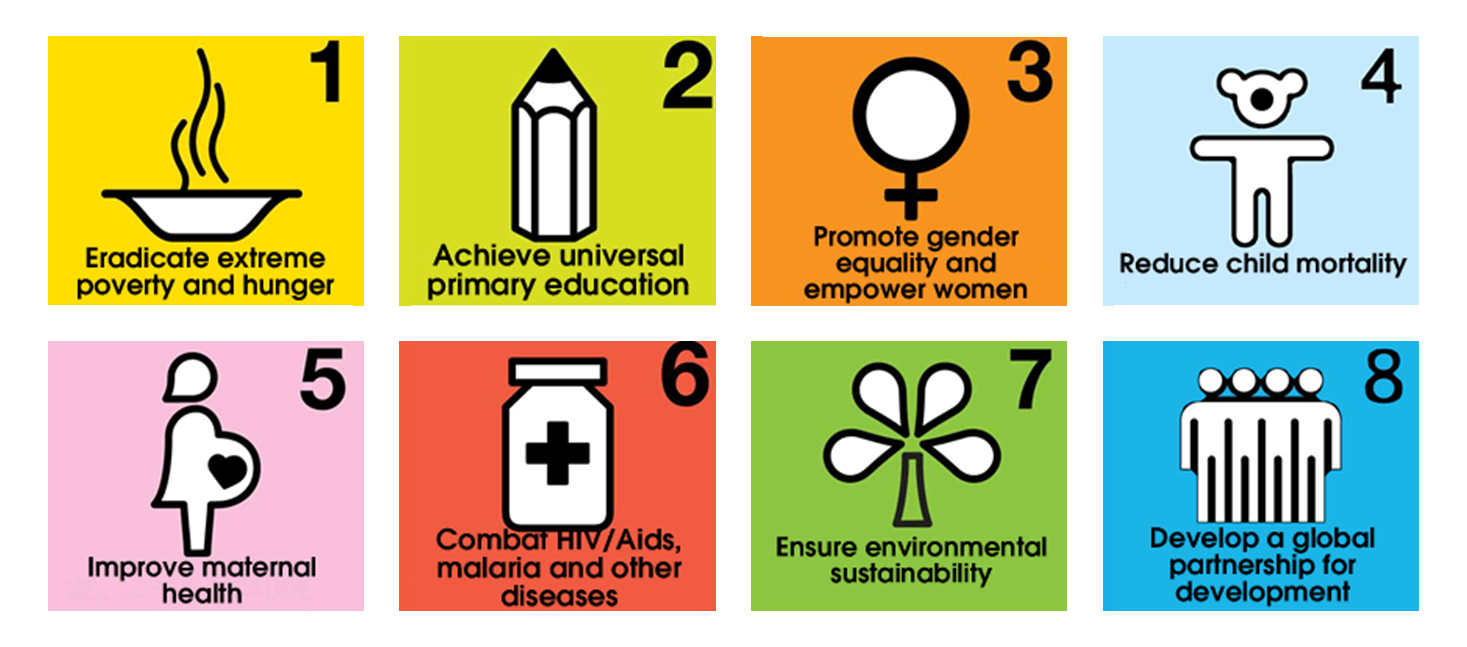
The Millennium Development Goals (MDGs) refer to the objectives that had been set during the Millennium Summit of the United Nations (UN) in 2000, which culminated in the UN Millennium Declaration. 189 member states of the UN, along with some international bodies, committed to help in achieving these objectives by the year 2015.
Some historical context may help the readers to fully understand these development goals. When the MDGs were set some 15 years ago, there were hopes and expectations worldwide, that these eight objectives could be met, across most of the developing world. Pakistan has by no means been the poor executor, however Pakistan has also not work towards achieving these MDGs wholeheartedly enough to assure that constant and significant breakthroughs occur.
One of the key reasons of the unfamiliarity about MDGs among Pakistani youth is the responsible factor of putting aside this long term agenda. During last fifteen years Pakistan has been governed by both military and democratic governments but this mega development agenda was neglected due to the absence of active citizenry participation on the long run.
Various media reports and think tanks in Pakistan found that the knowledge and information related to MDGs among university students is negligible. The more shocking conclusion is about 6-10 percent of the university student are aware about this term neglecting the huge chunk of other relatively less educated population. The aspect of informing and educating people about these goals had remained missing during past fifteen years through out the country.
Punjab, started well but still goals unachieved
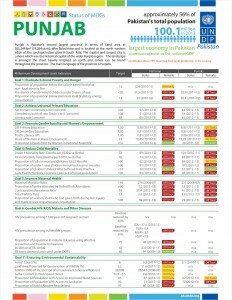 Shafiq Ahmad, a daily wage laborer from the outskirts of Rawalpindi, was 30 when the world adopted the MDGs in 2000. Now the fifteen years have passed and the deadline of MDGs is ending, a completely illiterate Shafiq is struggling to make ends meet. Living with five children Shafiq, who does a waiter job at the food point in Saddar Rawalpindi, is just paid Rs 3000 per month in the evening shift which starts from 6:00 pm till midnight.
Shafiq Ahmad, a daily wage laborer from the outskirts of Rawalpindi, was 30 when the world adopted the MDGs in 2000. Now the fifteen years have passed and the deadline of MDGs is ending, a completely illiterate Shafiq is struggling to make ends meet. Living with five children Shafiq, who does a waiter job at the food point in Saddar Rawalpindi, is just paid Rs 3000 per month in the evening shift which starts from 6:00 pm till midnight.
In early 2000s Punjab was the only province to which has linked its annual development investment with the MDGs and it has been declared by UNDP to be more progressive than other provinces in achieving goals by 2015. But for the majority of indicators the bigger breakthrough is still missing and it is off-track on various development indicators.
The government officials on the other hand are placing responsibility of off-tracking on the factors like economy at its lowest ebb, militancy, political instability, regular flooding and other factors. Various officials from the Punjab admitted that “Punjab was performing well on almost all the indicators before the initiation of economic growth which started booming in 2008”. “The continuous sad state of affairs in the province from the very beginning of the goals in 2000 is a reality moreover the fluctuation in the inflation, global financial crisis and decreasing aid from the donors affecting government ability to finance necessary development projects”. An official added.
Officials, however, on the other hand claimed that the current Shahbaz Sharif government was devoted in achieving MDGs goals by 2018. “The present government is the first one functioning for the accomplishment of the MDGs. The Punjab government is implementing the growth policy to expand the economy through macroeconomic projects to eight percent by 2018, eradicate poverty, create jobs, put children in school, improve health facilities and increase opportunities for women”. A provincial planning and development department informed.
Despite such claims many MDGs targets remained skeptical of the government adherence and power to bring off growth for achievement of targets in next three years. Unless the government actually allocate and spends more finances on the targeted areas, labor like Shafiq will never be able to get basic facilities like sending children to schools or access to clean drinking water and quality life.
Education goals out of reach: UNESCO
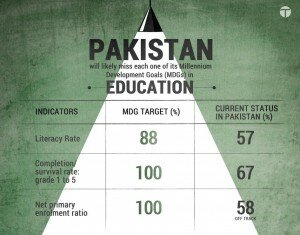 “As the MDGs approach their target date, 2015, more comprehensive goals are being set forth under the post-2015 development agenda. UN member states put forward seven post-2015 education targets compiled in SDG 4. These targets not only require that quality education be provided to all, but also that it is equitable – no one must be deprived on the basis of ethnicity, disability, race, gender or poverty in continuation of the EFA. The emphasis on gender equity in primary education (MDG goal 3) has been expanded in scope to all levels of education in the new agenda and in depth in terms of stressing gender equality and not only parity in numbers. Therefore, the Post-2015 goals now demand that comprehensive dis-aggregated data be available, and that new education indicators be globally comparable. Focus is on learning outcomes so that young men and women are able to learn the essentials for better livelihoods and social development of their communities”. Said Vibeke Jensen, Director UNESCO Pakistan.
“As the MDGs approach their target date, 2015, more comprehensive goals are being set forth under the post-2015 development agenda. UN member states put forward seven post-2015 education targets compiled in SDG 4. These targets not only require that quality education be provided to all, but also that it is equitable – no one must be deprived on the basis of ethnicity, disability, race, gender or poverty in continuation of the EFA. The emphasis on gender equity in primary education (MDG goal 3) has been expanded in scope to all levels of education in the new agenda and in depth in terms of stressing gender equality and not only parity in numbers. Therefore, the Post-2015 goals now demand that comprehensive dis-aggregated data be available, and that new education indicators be globally comparable. Focus is on learning outcomes so that young men and women are able to learn the essentials for better livelihoods and social development of their communities”. Said Vibeke Jensen, Director UNESCO Pakistan.
Pakistan has not achieved the MDG goals. All three indicators of MDG 2 (Net Primary Enrolment Ratio, Survival rate and Literacy rate) are off-track. The target primary NER was 100%, however, latest data suggests that the country stands at 72.5%. Evidence from the last 12 years indicates that primary net enrollment, an indicator of access to education, increased by 10 percentage points to 52 percent between 2001/02 and 2004/05 but has since stagnated. According to the Pakistan MDG Report 2013, only 57 percent of children of primary school age are enrolled in primary school, far below the national target of 100 percent. Furthermore, these indicators mask inter-provincial disparities: while NER is 65 percent in Punjab, it is only 39 percent in Balochistan. The survival/completion rate, an indicator of the quality of education, has declined since 2001, implying that only half of the children who start grade 1 will complete primary education. National-level surveys and statistics paint a dreary picture of the educational outcomes of government-run schools in the country. Similarly, on the third MDG 2 indicator (i.e. youth literacy rate), Pakistan stands at 58 percent, which is far behind its target of 88 percent for 2015. With the current pace of development on basic education indicators, it seems to be highly unlikely that the target of Universal Primary Education will be achieved by the end of year 2015, and much needs to be done to meet the 2025 Vision. She added.
State of well-being unsatisfied: WHO
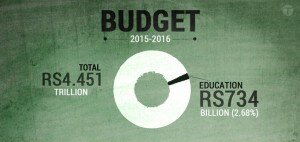 Pakistan is not on target for achieving the MDGs, mostly with respect of MDG4 (child mortality) and MDG 5 (maternal mortality). For any one thousand babies born alive in Pakistan, around 55 won’t survive their 28th day, 74 won’t make it after their first year, and around 89 will not reach five years of age. At the same time, between 22 and 25 mothers are dying every day in Pakistan giving birth.
Pakistan is not on target for achieving the MDGs, mostly with respect of MDG4 (child mortality) and MDG 5 (maternal mortality). For any one thousand babies born alive in Pakistan, around 55 won’t survive their 28th day, 74 won’t make it after their first year, and around 89 will not reach five years of age. At the same time, between 22 and 25 mothers are dying every day in Pakistan giving birth.
“Against considerable challenges, Pakistan has recently achieved the MDG target for Sanitation, after achieving the water target in 2012 (UNICEF/WHO Joint Monitoring Report 2015). In addition Pakistan has significantly reduced open defecation from 46 million to 25 million over the last 10 years. It is a remarkable achievement and Pakistan counts as the fifth best country globally in its efforts to reduce the proportion of those practicing open defecation, and second in the region behind Nepal”. Said Timothy Grieve, Chief, Water, Sanitation and Hygiene, UNICEF Pakistan.
“In Pakistan, we are seeing toilet use rapidly emerging as a new norm! To accelerate and sustain this positive momentum, provincial governments will need to further their commitments to up scaling investment in eliminating open defecation. However, there is still a long way to go, as vulnerable poor communities within the country continue to lack adequate water and sanitation services.” Grieve added.
To make progress on maternal and child mortality takes time. These progress result from a gradual integration of “systemic thinking” in the health sector, which has been severely defaulting in Pakistan in the past. When it comes to chase health gains for a population of 200M, it is indeed paramount to tackle health system building blocks such as access to affordable quality services, to well-trained competent human resources for health, to essential medicine and medical equipment, and to reliable health information attesting on population health trends. This also requires well designed and coherent national, federal and provincial health policy frameworks, in line with the constitutional realities of Pakistan.
Systemic thinking under the umbrella of rigorous health policies is taking momentum in Pakistan and it is expected that Pakistan will catch up decades-long delays in ensuring acceptable standards of population health.
For MDG 6 (malaria, TB and HIV), results are better as per target achievement. Yet, Pakistan remains the most malaria affected country in the region (WHO Eastern Mediterranean Region) with estimated 1.5 million malaria cases reported annually.
Pakistan ranks 4 among the 22 high tuberculosis burden in the world with 500,000 new cases of TB each year, many being multi-resistant to convention anti TB therapy; and despite a relatively low level of HIV transmission (less than 1%), fails to cover its 100 000 reported HIV positive patients with lifesaving anti retro-viral therapy (barely 9% while ARV coverage in neighboring South East Asian countries reached 95%).
The first and immediate set of measures is to “finish the agenda”. Pakistan must improve its results in maternal and child mortalities thorough intensified programs targeting the “continuum of care” meaning a set of systemic measure to address the health of child and her/his mother before, during and immediately after birth. The “Promise Renewed” Program recently endorsed by the MNHSR &C is a major step to that end. Large amount of resources are directed to alleviate morbidity and mortality for mothers and children.
A second set of measures is to embark the SDG agenda with clear health integrated and systemic programs, such as “universal access”, “health security coverage” and formulate health development targets accordingly. An SDG agenda scattered in many programmatic targets would diverge attention from the critical importance of systemic thinking as a strategy to secure population health gains.
A third set of measure is to regards health from both its macro-economic and social determinants which are encapsulated in many non-health SGDs (international trade and commerce, education, gender, environment, climate changes …).
Lack of capacity missing: UNDP
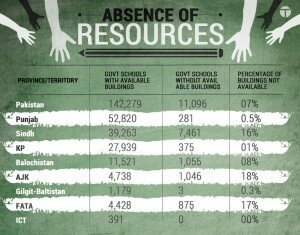 On the basis of evidence present in the form of statistics Pakistan has not achieved the desired targets and policy agenda remained missing throughout the long 15 years. In South Asian, region Pakistan is lagging behind all countries beside Afghanistan. Marc-Andre Franche, country director UNDP believed that “Lack of capacity to plan, deliver and implement is the basic point to look into it”.
On the basis of evidence present in the form of statistics Pakistan has not achieved the desired targets and policy agenda remained missing throughout the long 15 years. In South Asian, region Pakistan is lagging behind all countries beside Afghanistan. Marc-Andre Franche, country director UNDP believed that “Lack of capacity to plan, deliver and implement is the basic point to look into it”.
According to the National MDG 2013, Pakistan is off-track on 24 targets out of the total 33 indicators and its performance remains less satisfactory as compared to other countries in the Region.
The key lessons learned from the poor performance of the MDGs have multiple angels to review our priorities on the long run and such practices have to be avoided in implementation of the newly adopted SDGs.
Taking on the effective measures to implement MDGs Shakeel Ahmad, Assistant Country Director UNDP, Pakistan Said, “The Role of public policy is extremely important and alignment of the Public policy with the needs and priorities for social development. Capacities and capable institutions are the pre-requisites besides the exogenous constraints arising out of the security situation in the country, issues related to governance and weak institutions have played a major role in the non-achievement of MDGs”.
“Keeping in mind the localization and engagement at the sub-national level would have enhanced ownership and the division of responsibilities. Coordination between different tiers of government. This includes coherence among policies within and across governance levels and ownership of the international commitments for the implementation and monitoring of SDGs”. Ahmad told.
Pakistan has been placed with group of countries referred as “N-11” (N refers to Next). The country has been put among the nations outside BRICS, having an eminent potential to become a big global economy in 21st century. On the other hand the country is deplorably on the bottom in the world tax generation ranking. Out of 261 countries, Pakistan is at 202.
Furthermore, Participation and engagement of key actors including civil society and parliamentarians and the policy makers. Accountability and transparency essential for ensuring sustained and people responsive development.
SDGs a way forward
The UN member states adopted the Sustainable Development Goals in the 70th session of the General Assembly adopted the 2030 Agenda, including 17 inspiring Sustainable Development Goals commonly known as SDGs. The Prime Minister of Pakistan represented the Pakistan Delegation at the UN SDG Summit, which shows his personal and his government‘s commitment to SDGs.
The 17 SDGs and 169 targets represent a comprehensive global development agenda to be achieved over the next 15 years. The agenda is a plan of action for people, planet and prosperity. It also seeks to strengthen universal peace in larger freedom. Given the universality and comprehensiveness of the agenda, countries will need to adapt and localize it to their local context.
The new SDG agenda offers new opportunities for mobilizing education stakeholders at all levels, reviewing education policies and identifying new and effective strategies which will lead to universal primary and secondary education of quality for girls and boys regardless of ethnicity and class. If quantity and quality of education in Pakistan is not given a severe boost in the near future it will be very difficult, not to say impossible, for Pakistan to progress on any of the other 16 Sustainable Development goals.
During the recent UN session many countries leadership came with the detailed 15 years progress reports and Pakistan don’t even had its current one. Various experts believe that the political intervention rights from 2000 to present day these developmental indicators are vigorously neglected and funding has been inappropriately dealt.
There are several number of factors involved in the poor performance of the Pakistan in terms of providing the social cover to vulnerable citizens — the poor, the women and the children — from brutalizing the conditions of diverse shades of poverty.
Pakistan climbed seven steps on the global GDP ranking from 35th in 2000 to 27th currently, but had a slide on the global Gini Index to 113th out of 261 countries and regions reviewed. The Index measures the degree of inequality in distribution of family income in a country.
In vision 2025, the human capital development is always considered as the key area of public investment, but the current government seems to be more concerned about infrastructure and transportation ignoring the major chunk of poverty stricken population.
Haroon Janjua is 2015 UNCA Award Winner and holds 2015 IE Business School Prize for best journalistic work on Asian Economy. He can be reached on Twitter @JanjuaHaroon.


